ap bio chpt 5
1/105
Earn XP
Description and Tags
textbook notes (including HSR&T), GSN, michelle b's notes
Name | Mastery | Learn | Test | Matching | Spaced |
|---|
No study sessions yet.
106 Terms
what is a phospholipid?
amphipathic molecule (having both hydrophilic and hydrophobic regions)
head- hydrophilic, pointed outward (to aqueous medium or interior of cell)
tail- hydrophobic, pointed inward (interior of cell membrane)
the cell membrane is ________(NOT the same on both sides) and includes __________…
asymmetrical; carbohydrates, lipids, proteins (no nucleic acids!)
what is the phospholipid bilayer?
a thin, flat membrane made of two layers of phospholipids that forms a barrier around cells. It's the fundamental structure of the cell membrane, also known as the plasma membrane, and is found in almost all organisms and many viruses.
what 2 types of large proteins are in the phospholipid bilayer?
transmembrane proteins- span the whole membrane.
peripheral proteins- only on one side
what do the hydrophobic tails of the phospholipid bilayer want to “get away“ from?
they want to get away from the polar water, so the tails cluster together to minimize contact with water.
what makes 1 membrane different from the other is the…
the types of proteins integrated into the membrane. the pattern of the scattered proteins can vary from membrane to membrane.
what are the fully embedded proteins called?
integral proteins.
what are the proteins that are only attached to the cytoplasmic side of the membrane called?
peripheral proteins. for example: the G protein.
what is a fluid-mosaic model?
fluid- components interact and are flexible, consistency of olive oil (phospholipids)
mosaic- scattered proteins

go draw the fluid-mosaic model right now!
the drawing doesn’t have to be an exact replica or perfect, but just know the basics of it cuz it will be on the FRQ (most likely).
what type of cell is cholesterol found in?
only in animal cells! (the plant cell has cell walls instead)
the cholesterol fills in the _____ because of the…
kinks in the saturated phospholipids. this keeps the cell membrane intact.
what is the main function of cholesterol in the phosophilipid bilayer?
maintains and modifies the fluidity of a cell membrane over a range of temperature:
too hot - prevents it from becoming too fluid
too cold - prevents it from freezing
proteins in the phospholipid bilayer is what makes the membrane different and…
determines its functions.
what are the 2 types of integral proteins?
channel and carrier proteins
what are the functions of these proteins in the phospholipid bilayer?
multiple functions - transport, recognition, enzymatic, communication and connections
what is the extracellular matrix? (ECM)
it contains protein fibers and glycocalyx, and it assists with support and communication, and may anchor some proteins
what is glycocalyx?
carbohydrate side chains: glycolipids (attached to phospholipids) and glycoproteins (attached to proteins)
membrane overview:
inside- cytoplasm, may anchor some proteins.
outside- ECM.
emergent Properties - “the whole is greater than the sum of its parts”
responsible for the dynamic homeostasis between the external and internal environment of the cell
glycoproteins v.s glycolipids:
carbohydrate side-chains attached to proteins or lipids
unique - cell-to-cell: for adhesion and recognition. each cell’s “fingerprint”
glycolipids = cellular ID
glycoproteins = reception of signaling molecules
what do channel proteins do?
allow a particular molecule or ion to cross the plasma membrane freely
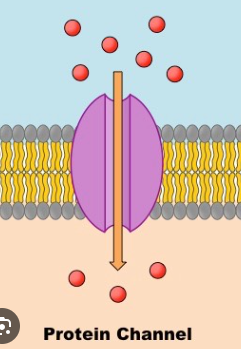
what is cystic fibrosis caused by?
it is caused by a faulty chloride channel (a thick mucus collects in airways and ducts).
what do carrier proteins do?
selectively interact with a specific molecule or ion (temporarily bind, changing shape) so it can cross the plasma membrane
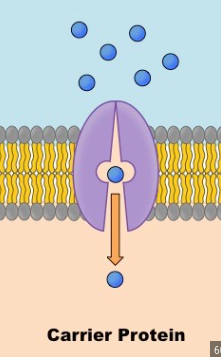
what does the sodium potassium pump do? what do problems with this lead to?
pumps 3 sodium out and 2 potassium in, using 30% of all the energy you make. problems with the Na/K pump could lead to obesity.
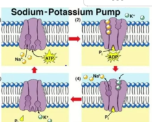
how do ions help the cell?
many ions in living things maintain homeostasis as they travel into/out of cells. ions also help transmit signals among cells that allow you to hear, see, taste, feel and smell.
what do cell recognition proteins do?
glycoproteins are part of the MHC (major histocompatibility complex), which helps a cell recognize self from non-self
can cause problems with organ donors

what do receptor proteins do?
are shaped so a specific molecule can bind to them

how do some forms of dwarfism occur?
when growth hormone receptors are faulty and don’t interact with the necessary hormone
what do enzymatic proteins do?
they catalyze a specific reaction

what is adenylate cyclase?
its an enzymatic protein that metabolizes ATP - cholera releases a toxin that interferes with this process
what are junction proteins?
it joins cells so they can work together as a tissue, performing a function together. these are only between animal cells, and without it, an animal embryo would have no nervous system.
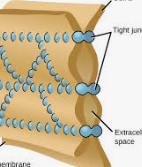
what are the 3 types of junctions between cells?
tight junctions-create a watertight seal between cells. used to connect cells of the intestine
adhesion junctions- firmly attach cells to each other for structural support. used to connect skin cells
gap junctions- allow for direct communication between cells by passing small molecules through channels between them. used by heart muscles because they permit ion flow to contract as a unit.
what is the permeability of the membrane?
it is semipermeable, which means that only certain molecules can pass through.
what type of molecules can pass through the semi-permeable membrane?
small(to slip between the hydrophillic heads), non-charged, usually nonpolar molecules can pass through by themselves (carbon dioxide, water, glycerol, alcohol, etc)
what are aquaporins?
a specialized channel protein that helps water quickly pass through the cell membrane (even though water is small, it is charged, so aquaporins help with its passage)
large or charged molecules can only pass thorough a cells membrane with the help of…
a channel or carrier.
substances that are hydrophobic, and therefore similar to the phospholipid center of the membrane are able to…
diffuse across membranes at no energy cost.
because polar molecules are chemically incompatible with the center of the membrane, they require…
an expenditure of energy to drive their transport.
molecules follow the ____________ as they move from an area where the concentration is ______ to a concentration that is _____.
concentration gradient ; high ; low
when does a bacterium that lives in your body respond to signalling molecules?
when it finds food and escapes immune cells in order to stay alive.
when does signalling help bread mold that grows on stale bread?
it detects an opposite mating strain to begin its sexual cycle
when do developing embryos respond to signalling molecules?
as they move to specific locations and become specific tissues
why are internal signals in newborn animals important?
internal signals such as hormones are essential to ensure that specific tissues develop when and how they should.
how do external signals work in plants?
external signals, such as light, tell the plant when it is time to resume growth or to flower
in general, what to internal and external signals do for plants and animals?
it enables them to coordinate their cellular activities, to metabolize, and to better respond in a changing enviorment.
the ability of cells to communicate with each other is an essential part of…
all biological systems.
how do cells talk to one another in a multicellular organism? (describe the insulin example)
they use sing-along molecules.
example: pancreas releases the hormone insulin. this hormone is then transported to the liver and the signal causes the liver to store glucose as glycogen. failure of the liver to respond appropriately is called diabetes.
what is a pancreas?
a gland in the abdomen that produces enzymes and hormones that help with digestion and regulating blood sugar levels
why do cells only respond to certain signals?
because they must bind to a receptor protein, and only cells that possess matching receptors can respond to certain signaling molecules.
what are the 3 types of cellular responces? (shown in a diagram on pg 87)
structural protein- altered shape or movement of cell
enzyme- altered metabolism or cellular function
gene regulatory protein- altered gene expression and the types and amount of proteins produced.
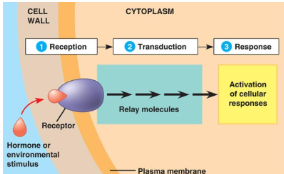
what is passive transport?
doesn’t use energy, but instead relies on the concentration gradient (higher concentration outside to lower concentration inside)
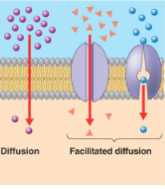
in passive transport, what can and cannot diffuse by themselves?
small non-charged molecules can diffuse by themselves
polar molecules may need a channel or carrier protein. this is called facilitated diffusion.
what is facilitated diffusion?
when a protein helps a molecule or ion cross the membrane
what is active transport?
requires energy and moves against the concentration gradient
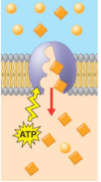
some types of active transport includes a ______(a carrier that requires ATP), endocytosis, and exocytosis.
pump.
ex.) sodium-potassium pump
why do cells respond to signals and “talk” to each other?
to coordinate their cellular activities, metabolize and better respond to a changing environment. For example - find food, a mate, develop and grow.
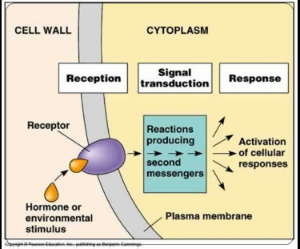
what is the process of cells talking to each other? (4 steps)
chemical messengers are sent to the cell
receptor receives the stimulus/signal
signal-transduction pathway is the series of events triggered
response is brought about by proteins and activates/triggers something within the cell
what are chemical messengers like?
like dialing out on your phone
what are receptor proteins like?
the one who receives the call after it bounces off a satellite. different cells have different combinations of receptors.
what is the signalling-transduction pathway?
the series of events/relay proteins triggered by the phone call/receptor.
what are the responces? (cells talking to each other)
brought about by proteins -It can activate an enzyme, trigger gene expression, alter metabolism, shape/movement of the cell etc..
what is diffusion?
movement of molecules from a higher concentration to a lower concentration. this happens all the time!
in diffusion, molecules move down their concentration gradient until…
the equilibrium is achieved and the molecules are distribute equally.
what is an example of diffusion? (use the crystal dye and water one)
when a crystal of dye is placed in water, the water molecules will move in various directions, but their net movement(sum of their motion), is towards the region of lower concentration. eventually, the dye is dissolved evenly in the water, resulting in equillibrium and a uniformly colored solution.
what is a solution?
contains solute (solid) and solvent (liquid)
what are solutions affected by?
temperature, pressure, electrical currents, molecular size
the chemical and physical properties of the plasma membrane allow only a few types of molecules to…
enter and exit a cell simply by diffusion. this is why gases can freely diffuse through the phsopholipid bilayer- because they are small and non-polar (oxygen entering, carbon dioxide exiting).
what is osmosis?
the diffusion of water or other solvent across a selectively permeable membrane. (could be other substances but usually water)
where to where must water flow in osmosis?
water must flow from the hypotonic side (high water potential) to the hypertonic side of the membrane (low water potential). “water must flow from the hypo”
how is osmosis different from diffusion?
diffusion is the movement of any molecule from an area of high concentration to low concentration, while osmosis is a specific type of diffusion where only water molecules move across a semipermeable membrane from a region of high water concentration to a region of low water concentration.
why would a solute not dissolve in a solution’s cells?
because the membranes are not permeable to the solute.
what is osmoregulation?
maintains water balance and allows organisms to control their internal solute composition/water potential
what is osmotic pressure?
the tendency of water to move across a membrane - higher osmotic pressure means more solutes and water will flow into that solution
the greater the possible osmotic pressure,…
the more likely it is that water will diffuse in that direction.
what is the highest possible water potential(distilled water)?
zero.
what is an isotonic solution?
its a solution that has osmotic pressure equal on both sides of the membrane. the water flow=no net change/loss of water. ex.) a 0.9% solution of the salt sodium chloride (NaCL) is known to be isotonic to red blood cells.
iso=same as, tonicity= the strength of the solution
what is a hypotonic solution?
a solution with a low concentration of solute (high concentration of water) than inside the cell.
hypo=less than
solutions that cause cells to swell, or even to burst, due to an intake of water are said to be ________ solutions
hypotonic
if a cell is placed in a hypotonic solution, then water will enter the cell. why?
because the low concentration of water prompts a net movement of water from the outside to the inside of the cell.
what does cytolysis mean?
animal cells, burst as water enters (in hemolysis, a red blood cell bursts)
what is hemolysis?
the term to describe cytolysis in red blood cells.
what is turgor pressure?
a cell wall in a bacteria or plant cell (made out of peptidoglycan or cellulose) resists an influx of water by pushing back
explain the turgor pressure process:
when a cell is placed in a hypotonic solution, the cytoplasm expands, because the large central vacuole gains water and the plasma membrane pushes against the rigid cell wall. the plant cell does not burst (unlike animal cells) because the cell wall does not give away.
why is turgor pressure for plant cells so important?
maintains the plants structure, helps keep it upright. plants wilt due to decreased turgor pressure.
what is negative water potential?
less potential energy than pure water
what is a hypertonic solution?
a solution with a higher percentage of solute (lower concentration of water) outside the cell.
hyper=more than
solutions that cause cells to shrink or shrivel due to loss of water are said to be _________ solutions
hypertonic
any concentration of a salt solution higher than 0.9% is hypertonic to red blood cells. if animal cells are placed in this solution, they shrink. what is the term that refers to the red blood cells in this condition?
crenation. ex.) meats are sometimes preserved by salting them. the bacteria are not killed by the salt but by the lack of water in the meat.
when a plant cell is placed in a hypertonic solution, the plasma membrane pulls away from the cell wall as the large central vacuole loses water. this is an example of _________.
plasmolysis. (the shrinking of the cytoplasm due to osmosis)
the dead plants you may see a long a salted roadside died because they were exposed to this. also, when salt water invades coastal marshes due to storms and human activities, costal plants die. without roots to hold the soil, it washes into the sea, doing away with many acres of valuable wetland. what are these examples of?
plasmolysis.
in facilitaed transport, the protein may undergo a conformational change during transport. what does this mean?
a change in the shape of a macromolecule, such as a protein, in response to environmental factors or other influences. example: a carrier protein.
a carrier protein undergoes a change in _______ as it moves a solute across the membrane
shape
explain the sodium potassium pump again cuz ig it’s important 🤷♀
Na+/K+ ATPase (sodium-potassium pump) - same protein that pumps 3 sodium molecules to the outside of a cell, pumps 2 potassium ions to the inside, using ATP. This sets up an electrochemical gradient (membranes become polarized) that all neurons (nerve cells) require to function
NaCl transport is important to many cells -sodium is actively transported and chloride ions will passively follow.
what is bulk transport?
large particles, or large quantities of small particles, can be moved across the membrane. uses the entire membrane. they are too large to be transported by carrier proteins, so instead they are transported in and out by vesicles
what is exocytosis?
a vesicle formed by the golgi apparatus fuses with the plasma membrane to secrete substances such as hormones, neurotransmitters and enzymes. —> moves stuff out of cell
what does secrete mean?
to produce and release a substance
what is endocytosis? what are the 3 types?
it engulfs a substance and brings it in. the 3 types are phagocytosis, pinocytosis, and receptor-mediated endocytosis.
what is phagocytosis?
cellular eating - large molecules engulfed (a white blood cell eating a bacterium)
what is pinocytosis?
cellular drinking - vesicles form around fluids (plant root cells)
what is receptor-mediated endocytosis?
a form of pinocytosis where a specific macromolecule binds to receptors (selective and more efficient than pinocytosis) - used to move substances from maternal to fetal blood